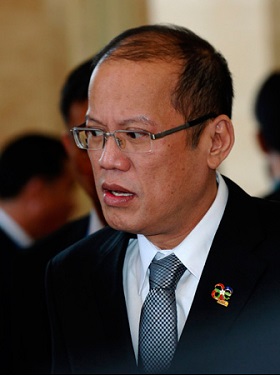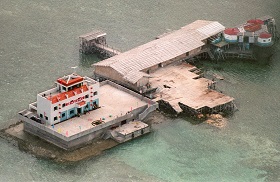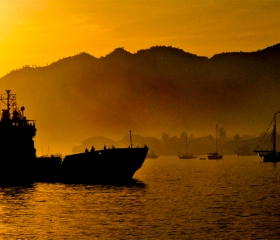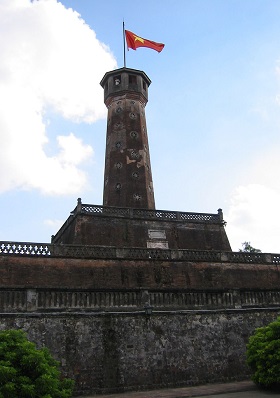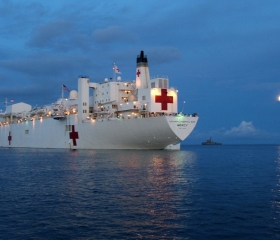The latest developments in the South China Sea conflict between China and the Philippines, Vietnam and Malaysia have been escalating tensions in the region and affecting the conflict's entire political configuration. The issue is China's decision to deploy maritime policing vessels for inspecting, if necessary, vessels belonging other countries in the part of the South China Sea that China claims to be under its jurisdiction (about 80% of the total area), and the initiation by the Philippines of UNCLOS Arbitral Proceedings against China in an attempt to settle the territorial dispute with Beijing.
The Philippines Toughen Policy toward China
On January 22, 2013, Albert del Rosario, the Secretary of Foreign Affairs of the Philippines, declared that “China’s maritime claims in the South China Sea based on its so-called nine-dash line are contrary to UNCLOS and invalid.” “The Philippines has exhausted almost all political and diplomatic avenues for a peaceful negotiated settlement of its maritime dispute with China,” said the minister. He expressed hope that the Arbitral Proceedings would grant the dispute a long-term solution.
Explaining the reasons for this unexpected declaration, which threatens to undermine the existing bargaining system in the conflict over the disputed islands, Albert del Rosario emphasized that the Philippines have been exchanging thoughts with China regarding peaceful settlement of the dispute ever since 1995, but that at present “the negotiations have hit a wall.”
The first question arising in connection with this statement is why it had not been made when the Philippines and China were poised on the brink of a “small war” (most recently in the fall of 2012, when Philippine and Chinese patrol boats had a several-day standoff, just waiting for the order to open fire), but only now, in a much more relaxed atmosphere.
At first glance, this is an emotional response to the continuous pressure from China. The Philippine government may have concluded that its reaction to the actions of Chinese ships during the conflict's most recent escalation in November 2012 was not tough enough, and decided to make up for lost time a few months later. By demonstrating a hardline position, Philippine President Benigno Aquino wanted to strengthen electoral support and show voters his determination and patriotism. However, there is another possible explanation: the Philippine government wished to show its ASEAN partners the right way to achieve their goals when confronting China. After its scandalous failure at the last ASEAN Summit in Phnom Penh (Cambodia), when the draft resolution prepared by the Philippines was not supported by Association members, the Philippine government probably decided to act on its authority in the hope that ASEAN solidarity would eventually develop, and that Manila would gain support and virtually assume leadership of the Association. However, these hopes have so far proved to be unfounded. The forceful Philippine démarche unsurprisingly failed to secure the support of the Vietnamese, the Malaysians and the Bruneians, who also claim sovereignty over islands in the South China Sea. ASEAN colleagues preferred to keep quiet so as not to worsen their own relations with China by rendering support to Manila. Thus, the Philippines is now out in the cold, with its ASEAN partners unlikely to back it up unless something extraordinary happens.
The Philippines Is Not Alone
In fact, the Philippines’ loneliness is rather relative. Manila certainly enjoys the support of the United States, which has long sought to turn the conflict in the South China Sea from bilateral (China and its opponents) into a multilateral and international one. And the Philippines is doing exactly that. Washington is also interested in keeping tension in the South China Sea high. After all, this is a large part of the reason Philippine-American relations, as well as relationships between the USA and many other countries in the region have gained a "second wind". It was after the Mischief Reef incident that the Philippines once again felt the need for US support, and appealed directly to the US for help in 2008 against a background of escalating conflict, stating its readiness to accept the ships of the US Navy, and reconnaissance aircraft.
The possibility of increased US military presence in the Philippines is currently being negotiated to reinforce the 600 military advisers stationed on the island of Mindanao since 2002 to help fight the Islamists in the south of the country [1]. In May 2012 it was reported that Washington was planning to triple military aid to Manila in order to strengthen ties between the two countries, and in view of deterioration of relations with China. According to the US embassy, in 2002 Manila received nearly $500 million from the United States in military aid, not counting the cost of the 20 renovated helicopters and Cyclone and Hamilton class patrol vessels handed over to the Philippine side [1].
It seems that Washington wished to demonstrate its trump card to the new PRC leaders, and chose to do so by taking advantage of its Philippine ally's striking move. Moreover, the Americans were able to give an asymmetrical response to Beijing's extremely controversial statement that, from January 1, 2013, Hainan Province police would be authorized to board and detain ships suspected of "illegal" entry into what China claimed to be its territorial waters in the South China Sea [2]. This decision was severely criticized by the ASEAN leadership. Thus, ASEAN’s Secretary-General Surin Pitsuwan said that Asia was entering its “most contentious” period in recent years. Indeed, he called the Chinese decision an escalation of existing tensions that could intensify the conflict.
Justifying this decision, Foreign Ministry spokesman Hong Lei pointed out that "the navigation freedom countries enjoy in the South China Sea according to international law should be protected." Stating that “China attaches importance to maintaining navigation freedom in the South China Sea” he added that “there is no problem with it.” [2] In fact, the the Chinese representative's statement was an attempt to conceal a new, fundamentally different state of affairs: before the promulgation of the new rules, freedom of navigation in the South China Sea was taken for granted, but now it depends on the good will of the Chinese authorities. Today, Beijing is ready to demonstrate good will, but what will happen tomorrow? This question is essential because the stakes are too high. The tonnage of oil transported by sea through the Malacca Strait and the South China Sea is 6 times greater than that passing through the Suez Canal, and 16 times more than that through the Panama Canal. These shipments cover almost two-thirds of the energy supply to South Korea] and about 60% of that to Japan and Taiwan. A huge flow of goods goes to the west coast of the United States and the Russian Far East. Up to 200 merchant ships sail in these waters each day, or 60 thousand per year (as of 2006) [3].
It should also be noted that the determination and resoluteness displayed by the Philippines in its confrontation with China both before and today reflect socio-cultural differences. The Philippines has always been the most western-minded country in South-East Asia, and one which, for historical reasons, has borrowed little if anything from Chinese culture. Largely because of this, Filipinos have never held China in particular reverence and have never regarded the latter as the historical and cultural nexus of the East Asian region. Manila values political, economic and cultural ties with the United States immeasurably more than the relations with China, which lack historical depth and are shaped by purely pragmatic considerations.
A Hard Decision for Vietnam
Following the events in the South China Sea, the Vietnamese leadership faces a difficult choice. On the one hand, China is infringing Vietnam's sovereign rights to the islands in the South China Sea, having arbitrarily established the nine-dash area covering 80% of the Sea. On the other hand, Vietnam’s relations with China go back a long way – the two countries have economic, political, historical, and even inter-party ties and shared interests. Hanoi is apparently aware of the relationship between Philippine actions and U.S. policy, which prejudices Manila’s stance in the conflict as the one of an entirely independent actor. The apparent restraint displayed by Vietnam in relation to the US-Philippine project is also an important signal to China that the country's leadership expects continued negotiations with the “northern neighbor.” Whether this neighbor is able and willing to correctly understand and interpret the signal is another matter. If the policy of restricting Vietnamese fishing and economic activities in the disputed areas continues, the already strained relations between Vietnam and China could deteriorate further, and no special relationship and inter-party ties will be enough to stabilize it.
Thus, the difficult problem facing Vietnam is how to escape being used as a pawn in someone else's game on the one hand, and to leave the door open for possible contacts with China's new leadership of on the other. Existing disagreements and conflicts notwithstanding, there is no denying that Vietnam is interested in promoting cooperation with China, especially in the socio-economic sphere which is vital for the country's sustainable development. The most realistic way to achieve success may be to maintain a multi-vector foreign policy, which was first proclaimed in the early 1990s and has proved to be effective. This course allows Vietnam to develop relationships on an equal basis with India, Russia, the US, Australia and other countries, which in turn helps keep balance in its relationship with China.
China’s Choice
As for China, its leadership faces a serious decision as well. The Chinese have already demonstrated their rejection of the Filipino action. According to the Foreign Ministry spokesman], this “complicates the issue”. After a certain delay, China assumed an even tougher position, declaring that the international court was illegal and that it was unwilling to abide by its decisions.
The dilemma facing the Chinese leadership is how to punish Manila without leading the ASEAN members to unite on an anti-Chinese basis. Stepping up military pressure is bound to push the ASEAN countries, particularly Vietnam and the Philippines, into uniting, as happened during the 2011 crisis, and would provoke new appeals to the United States and international institutions for support. Too mild a reaction to the Philippines’ initiative could be interpreted by China's neighbors in Southeast Asia as the new leadership’s lack of confidence in its own strength. In the meantime, Beijing continues the old course. The South China Sea Fishery Bureau under the Ministry of Agriculture recently announced that China will conduct daily military patrols of fishing zones in the South China Sea “to better safeguard the legitimate interests of domestic fishermen”.
The US Position
The dramatic action of the Philippines highlighted the complex dilemma that faces the United States today. The issue at hand is working out a policy that would allow the US to use its strong position in South East Asia and force China to make concessions both in bilateral relations and in international economics and politics. Until important questions are resolved, the US will be extremely interested in allowing unrest in the South China Sea to continue. Washington spares no effort in encouraging ASEAN countries concerned about the growth of Chinese influence to form an anti-Chinese geopolitical zone. The Americans demonstrate their support of and commitment to focusing power and resources in the Asia-Pacific region at all levels, as made plain by the new US military doctrine made public on January 5, 2012.
Thus, America has to determine the limits of pressure that can be exerted on China without driving Beijing into a corner where resorting to military action would seem the best remaining option. At the same time, the US may miss the opportunity to force China to make concessions without the threat of a major war.
* * *
It can be argued that the conflict in the South China Sea has entered a new phase. Moreover, this phase poses a much greater threat to international security than ever before. An extremely serious confrontation may be immediately triggered now not only by another detention of fishermen or an act of sabotage against oil prospectors, but by the Chinese police stopping even a single vessel in the South China Sea for inspection. Then the fishery and oil transportation issues will recede into the background, while the problem of freedom of navigation in this key region for international trade will come to the fore. The conflict will go beyond bilateral or even regional scope and develop into a clash with global consequences for international stability. What will the Americans, the Japanese or the Koreans do if this scenario comes true? What will be the reaction of Russia? And how will China respond? The peace and security of our planet will depend on the answers to these questions.
1. Voyennoye Obozreniye magazine, June 18, 2012.
2. The Straits Times, 01.12.2012.
3. Asian Survey. 2006.Vol. XLVI. № 4. July/August.


